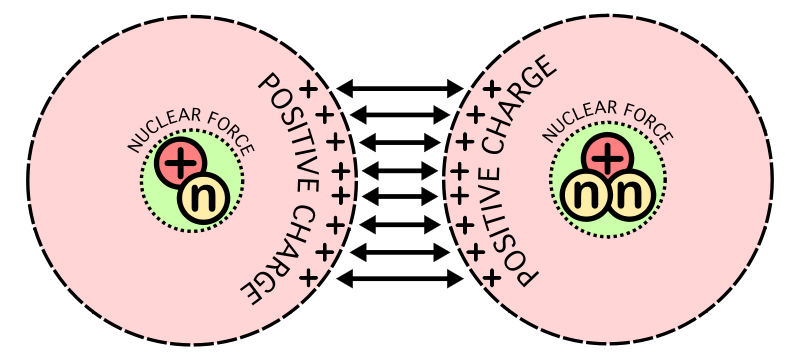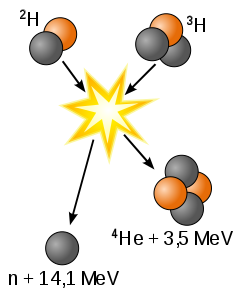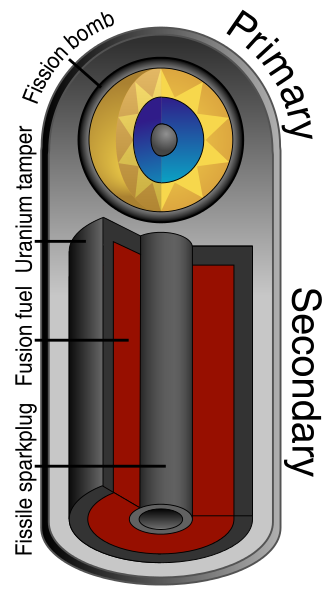38 Nuclear Fusion
LumenLearning
Nuclear Fusion
Nuclear fusion is the process by which two or more atomic nuclei join together to form a single heavier nucleus and large amounts of energy.
LEARNING OBJECTIVES
Describe the electrostatic and strong nuclear forces and how they act to oppose or promote a fusion reaction
KEY TAKEAWAYS
Key Points
- The origin of the energy released in fusion of light elements is due to an interplay of two opposing forces: the nuclear force that draws together protons and neutrons, and the Coulomb force that causes protons to repel each other.
- Fusion reactions of light elements power the stars and produce virtually all elements in a process called nucleosynthesis.
- A substantial energy barrier of electrostatic forces must be overcome before fusion can occur.
Key Terms
- nuclear binding energy: The energy required to split a nucleus of an atom into its component parts.
- nucleon: One of the subatomic particles of the atomic nucleus, i.e. a proton or a neutron.
- nucleosynthesis: Any of several processes that lead to the synthesis of heavier atomic nuclei.
- nuclear force: The force that acts between nucleons and binds protons and neutrons into atomic nuclei; the residual strong force.
- nuclear fusion: A reaction in which two or more atomic nuclei collide at very high speed and join to form a new type of atomic nucleus
Nuclear Fusion
Nuclear fusion is the process by which two or more atomic nuclei join together, or “fuse,” to form a single heavier nucleus. During this process, matter is not conserved because some of the mass of the fusing nuclei is converted to energy, which is released. Fusion is the process that powers active stars, releasing large quantities of energy.
The origin of the energy released in fusion of light elements is due to an interplay of two opposing forces: the nuclear force that draws together protons and neutrons, and the Coulomb force that causes protons to repel each other. The protons are positively charged and repel each other, but they nonetheless stick together, demonstrating the existence of another force referred to as nuclear attraction. This force, called the strong nuclear force, overcomes electric repulsion in a very close range.
Fusion and Strong Nuclear Force
The effect of nuclear force is not observed outside the nucleus, hence the force has a strong dependence on distance; it a short-range force. The same force also pulls the nucleons, or neutrons and protons, together. The nuclear force is stronger than the Coulomb force for atomic nuclei smaller than iron, so building up these nuclei from lighter nuclei by fusion releases the extra energy from the net attraction of these particles. For larger nuclei, no energy is released, since the nuclear force is short-range and cannot continue to act across an even larger atomic nuclei. Therefore, energy is no longer released when such nuclei are made by fusion; instead, energy is absorbed.
Examples of Fusion
Fusion reactions of light elements power the stars and produce virtually all elements in a process called nucleosynthesis. The fusion of lighter elements in stars releases energy, as well as the mass that always accompanies it. For example, in the fusion of two hydrogen nuclei to form helium, seven-tenths of one percent of the mass is carried away from the system in the form of kinetic energy or other forms of energy, like electromagnetic radiation.
Requirements
A substantial energy barrier of electrostatic forces must be overcome before fusion can occur. At large distances, two nuclei repel one another because of the repulsive electrostatic force between their positively charged protons. If two nuclei can be brought close enough together, however, the electrostatic repulsion can be overcome by the attractive nuclear force, which is stronger at close distances.

When a nucleon is added to a nucleus, the nuclear force attracts it to other nucleons, but primarily to its immediate neighbors due to the short range of the force. The nucleons in the interior of a nucleus have more neighboring nucleons than do those on the surface. The binding energy per nucleon generally increases with the size of the nucleus but approaches a limiting value corresponding to that of a nucleus with a diameter of about four nucleons.
The electrostatic force, on the other hand, is dependent upon the inverse-square of the distance between two like-charged particles, so a proton added to a nucleus will feel an electrostatic repulsion from all the other protons in the nucleus. The electrostatic energy per nucleon increases without limit as nuclei get larger due to the electrostatic force.
Fusion Reactors
A fusion reactor is designed to use the thermal energy from nuclear fusion to produce electricity.
LEARNING OBJECTIVES
State the Lawson criterion for a fusion reactor to be viable
KEY TAKEAWAYS
Key Points
- In fusion reactions, two light atomic nuclei fuse together to form a heavier nucleus and release a large amount of energy.
- The basic concept behind any fusion reaction is to bring two light nuclei close enough so the residual strong force (nuclear force) in their nuclei will pull them together.
- The fused nuclei of two smaller atoms form a single nucleus with a slightly smaller mass, providing energy according to [latex]\text{E = mc}^2[/latex].
- Fusion between the nuclei is opposed by the repulsive positive electrical charge common to all nuclei because they contain protons.
Key Terms
- plasma: A state of matter consisting of partially ionized gas.
Reviewing Fusion
Fusion power is the power generated by nuclear fusion processes. In fusion reactions, two light atomic nuclei fuse together to form a heavier nucleus. In doing so, they release a comparatively large amount of energy that arises from the binding energy, creating an increase in temperature of the reactants. To harness fusion power, a fusion reactor must be built to turn the energy released by fusion into electricity.
Harnessing Fusion Power
The term “fusion power” is commonly used to refer to potential commercial production of net usable power from a fusion source, similar to the usage of the term “steam power.” Heat from the fusion reactions is used to operate a steam turbine which in turn drives electrical generators. This is similar to the process used in fossil fuel and nuclear fission power stations.
Conflicting Energies
The basic concept behind any fusion reaction is to bring two or more nuclei close enough so that the residual strong force (nuclear force) in their nuclei will pull them together into one larger nucleus. Fusion between the nuclei is opposed by the repulsive positive electrical charge common to all nuclei because they contain protons. To overcome this electrostatic force, or “Coulomb barrier,” the kinetic energy of the atoms must be increased. The easiest way to do this is to heat the atoms, which has the side effect of stripping their electrons and leaving them as bare nuclei.
Fusion and Energy Concerns
If two light nuclei fuse, they will generally form a single nucleus with a slightly smaller mass than the sum of their original masses; this is not true in every case, though. The difference in mass is released as energy according to Albert Einstein’s mass-energy equivalence formula, [latex]\text{E = mc}^2[/latex]. If the input nuclei are sufficiently massive, the resulting fusion product will be heavier than the sum of the reactants’ original masses, in which case the reaction requires an external source of energy. The dividing line between “light” and “heavy” is iron-56. Above this atomic mass, energy will generally be released by nuclear fission reactions; below this mass, energy will be released by fusion.
In most experiments, the nuclei and electrons are left in a fluid known as a plasma, which is a state of matter that occurs when a gas is heated to extreme temperatures. The temperatures required to provide the nuclei with enough energy to overcome their repulsion is a function of the total charge. Therefore, hydrogen, which has the smallest nuclear charge, fuses at the lowest temperature, and is often used as fuel. Helium has an extremely low mass per nucleon and therefore is energetically favored as a fusion product. As a consequence, most fusion reactions combine isotopes of hydrogen (protium, [latex]^1\text{H}[/latex]; deuterium, [latex]^2\text{H}[/latex] or D; and tritium, [latex]^3 \text{H}[/latex] or T) to form isotopes of helium ([latex]^3\text{He}[/latex] or [latex]^4\text{He}[/latex]) as the fusion end product.
Fuel cycles
The choice of fuel for a fusion reactor is dictated by a term called the Lawson criterion. It was first derived for fusion reactors by John D. Lawson in 1955, and published in 1957. The Lawson criterion is an important general measure of a system that defines the conditions needed for a fusion reactor to reach ignition. Namely, the heating of the plasma by the products of the fusion reactions must be sufficient to maintain the temperature of the plasma against all losses without external power input.
According to the Lawson criterion, the easiest and most immediately promising nuclear reaction for fusion power is:
[latex]_1^2 \text{D} + \ _1^3 \text{T} \rightarrow \ _2^4 \text{He} + \ _0^1 \text{n}[/latex]

Hydrogen-2, called deuterium, is a naturally occurring isotope of hydrogen and is commonly available. The large mass ratio of the hydrogen isotopes makes their separation easy compared to the difficult uranium enrichment process. Hydrogen-3, called tritium, is also an isotope of hydrogen, but it occurs naturally in only negligible amounts due to its half-life of 12.32 years. Consequently, the deuterium-tritium fuel cycle requires the breeding of tritium from lithium using one of the following reactions:
[latex]_0^1 \text{n} + \ _3^6 \text{Li} \rightarrow \ _1^3 \text{T} + \ _2^4 \text{He}[/latex]
[latex]_0^1 \text{n} + \ _3^7 \text{Li} \rightarrow \ _1^3 \text{T} + \ _2^4 \text{He} + \ _0^1 \text{n}[/latex]
The reactant neutron is supplied by the D-T fusion reaction shown earlier. It is the one that has the greatest yield of energy. The reaction with [latex]^6\text{Li}[/latex] is exothermic, providing a small energy gain for the reactor. The reaction with [latex]^7\text{Li}[/latex] is endothermic but does not consume the neutron. At least some [latex]^7\text{Li}[/latex] reactions are required to replace the neutrons lost to absorption by other elements.
The Hydrogen Bomb
The hydrogen bomb is a nuclear weapon that uses a mixture of fission and fusion to produce a massive explosion.
LEARNING OBJECTIVES
Recognize the components of a hydrogen bomb
KEY TAKEAWAYS
Key Points
- A thermonuclear weapon is a nuclear weapon design that uses the heat generated by a fission bomb to compress a nuclear fusion stage.
- The basic principle of the Teller–Ulam configuration, the most common configuration of hydrogen bombs, is the idea that different parts of a thermonuclear weapon can be chained together in “stages,” with the detonation of each stage providing the energy necessary to ignite the next stage.
- The nuclear fusion in an H-bomb releases neutrons much faster than a fission reaction, and these neutrons then bombard the remaining fissile fuel, causing it to undergo fission much more rapidly.
Key Terms
- thermonuclear: Of, or relating to, the fusion of atomic nuclei at high temperatures. Also, relating to the use of atomic weapons based on such fusion.
- fusion: A nuclear reaction in which nuclei combine to form more massive nuclei with the concomitant release of energy and often neutrons.
Thermonuclear Weapons
A thermonuclear weapon is a nuclear weapon designed to use the heat generated by a fission bomb to compress a nuclear fusion stage. This indirectly results in a greatly increased energy yield, i.e., the bomb’s “power.” This type of weapon is referred to as a hydrogen bomb, or H-bomb, because it employs hydrogen fusion. Oddly, in most applications, the majority of its destructive energy comes from uranium fission, not hydrogen fusion alone. The fusion stage in these types of weapons is required in order to efficiently create the large quantities of fission that are characteristic of most thermonuclear weapons.
Features of a Hydrogen Bomb

The essential features of a mature, thermonuclear weapon design, which officially remained secret for nearly three decades, are the following:
- First, the stages of the weapon are separated into a triggering, primary explosive and a much more powerful secondary explosive.
- After this, the secondary explosive is compressed by X-rays coming from the nuclear fission of the primary explosive. This process is called the “radiation implosion” of the secondary explosive.
- Finally, the secondary explosive is heated, after cold compression, by a second fission explosion that occurs inside the secondary explosive.
The most common bomb design that employs these features is called the Teller-Ulam configuration. It should be noted that no hydrogen bomb has ever been used during the course of an actual war. The only two nuclear weapons that have been used were both fission-based.
The most important principle of the Teller–Ulam configuration is the idea that different parts of a thermonuclear weapon can be chained together in “stages,” in which the detonation of each stage provides the energy necessary to ignite the next stage. At a bare minimum, this includes a primary section, which consists of a fission bomb (a “trigger”) and a secondary section which consists of fusion fuel. The energy released by the primary section compresses the secondary through a process called “radiation implosion,” at which point it is heated and undergoes nuclear fusion.
The nuclear fusion releases neutrons much faster than a fission reaction, and these neutrons then bombard the remaining fissile fuel, causing it to undergo fission much more rapidly. As such, the main explosive force for the explosion still arises from a fission reaction, but the neutron source for it arises from fusion.
Due to the staged design, it is thought that a tertiary section, again comprised of fusion fuel, could be added after the first two stages, based on the same principle that governs the secondary. A different design, the AN602 “Tsar Bomba,” is thought to have been a three-stage device.
LICENSES AND ATTRIBUTIONS
CC LICENSED CONTENT, SHARED PREVIOUSLY
- Curation and Revision. Provided by: Boundless.com. License: CC BY-SA: Attribution-ShareAlike
CC LICENSED CONTENT, SPECIFIC ATTRIBUTION
- Nuclear fusion. Provided by: Wikipedia. Located at: http://en.wikipedia.org/wiki/Nuclear_fusion. License: CC BY-SA: Attribution-ShareAlike
- nuclear fusion. Provided by: Wikipedia. Located at: http://en.wikipedia.org/wiki/nuclear%20fusion. License: CC BY-SA: Attribution-ShareAlike
- nucleosynthesis. Provided by: Wiktionary. Located at: http://en.wiktionary.org/wiki/nucleosynthesis. License: CC BY-SA: Attribution-ShareAlike
- nuclear binding energy. Provided by: Wikipedia. Located at: http://en.wikipedia.org/wiki/nuclear%20binding%20energy. License: CC BY-SA: Attribution-ShareAlike
- nucleon. Provided by: Wiktionary. Located at: http://en.wiktionary.org/wiki/nucleon. License: CC BY-SA: Attribution-ShareAlike
- nuclear force. Provided by: Wiktionary. Located at: http://en.wiktionary.org/wiki/nuclear_force. License: CC BY-SA: Attribution-ShareAlike
- Nuclear fusion. Provided by: Wikipedia. Located at: http://en.wikipedia.org/wiki/Nuclear_fusion. License: Public Domain: No Known Copyright
- Fusion power. Provided by: Wikipedia. Located at: http://en.wikipedia.org/wiki/Fusion_power. License: CC BY-SA: Attribution-ShareAlike
- Lawson criterion. Provided by: Wikipedia. Located at: http://en.wikipedia.org/wiki/Lawson_criterion. License: CC BY-SA: Attribution-ShareAlike
- plasma. Provided by: Wiktionary. Located at: http://en.wiktionary.org/wiki/plasma. License: CC BY-SA: Attribution-ShareAlike
- Nuclear fusion. Provided by: Wikipedia. Located at: http://en.wikipedia.org/wiki/Nuclear_fusion. License: Public Domain: No Known Copyright
- Nuclear%252520fusion. Provided by: Wikipedia. Located at: http://en.wikipedia.org/wiki/Nuclear_fusion. License: Public Domain: No Known Copyright
- Hydrogen bomb. Provided by: Wikipedia. Located at: http://en.wikipedia.org/wiki/Hydrogen_bomb. License: CC BY-SA: Attribution-ShareAlike
- fusion. Provided by: Wiktionary. Located at: http://en.wiktionary.org/wiki/fusion. License: CC BY-SA: Attribution-ShareAlike
- thermonuclear. Provided by: Wiktionary. Located at: http://en.wiktionary.org/wiki/thermonuclear. License: CC BY-SA: Attribution-ShareAlike
- Nuclear fusion. Provided by: Wikipedia. Located at: http://en.wikipedia.org/wiki/Nuclear_fusion. License: Public Domain: No Known Copyright
- Nuclear%252520fusion. Provided by: Wikipedia. Located at: http://en.wikipedia.org/wiki/Nuclear_fusion. License: Public Domain: No Known Copyright
- File:Teller-Ulam device 3D.svg – Wikipedia, the free encyclopedia. Provided by: Wikipedia. Located at: http://en.wikipedia.org/w/index.php?title=File:Teller-Ulam_device_3D.svg&page=1. License: Public Domain: No Known Copyright
This chapter is an adaptation of the chapter "Nuclear Fusion" in Boundless Chemistry by LumenLearning and is licensed under a CC BY-SA 4.0 license.
energy lost when an atom’s nucleons are bound together (or the energy needed to break a nucleus into its constituent protons and neutrons)
collective term for protons and neutrons in a nucleus

